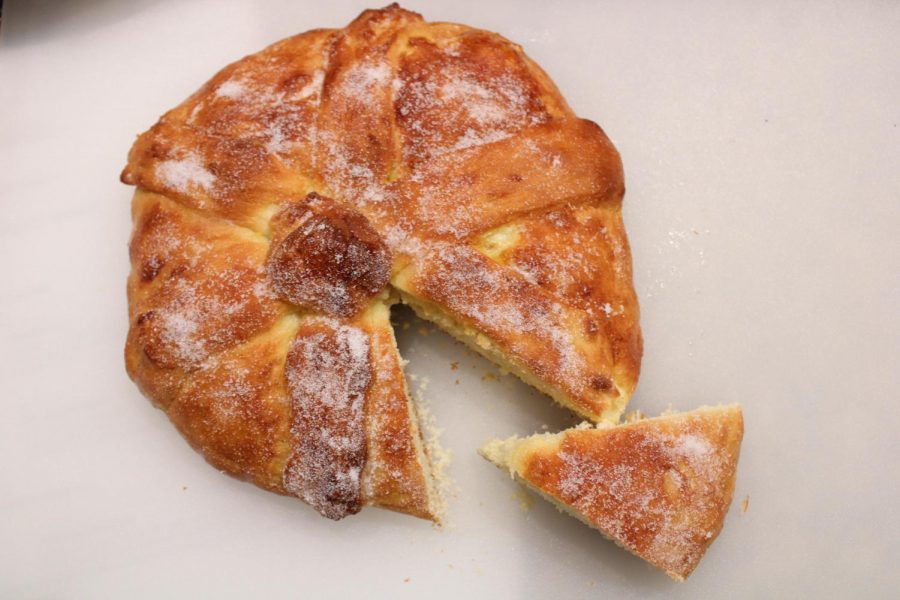El Día de los Muertos: Una Receta Fantástica
October 30, 2021
Día de los Muertos, or the Day of the Dead, is a holiday that originated in Mexico and is now widely celebrated across the world. Observed from October 31st through November 2nd, the dead are remembered, honored, and celebrated. Altars are built for those who have passed on.amilies put pictures of their loved ones along with an array of different significant offerings like candles, sugar skulls and pan de muerto, or bread of the dead.
A common theme of the holiday is food, which plays a significant role on he altars. Although all families use their own food, the two traditional foods that you are almost certain to find on any altar on Day of the Dead are pan de muerto and sugar skulls. Pan de muerto or “bread of the dead,” is a traditional Mexican sweet bread, representing an offering made to the loved one. Although the family are the ones who eat the bread, it is believed that when the spirit of the family member returns during the Day of the Dead, it will be nourished by the “essence” of the bread. The shape of it is also significant. Forming a cross on the top of the bread is meant to symbolize bones. On top of the “bones” there is a small ball representing the tears shed for the dead, a skull, or the heart.
The biggest symbols of Dia de los Muertos are the skeletons and skulls. Bones are everywhere, from parades and decorations, and even foods. In big cities, you will find parades filled with musicians, dancers, and many people who are dressed up. One of the most popular characters to dress up as is “La Calavera Catrina” (The Elegant Skull), a skeleton who resembles a high class female, showing that, in death, rich and poor are equal. Despite the many skeletons parading through the streets with the belief that spirits have returned to be with their families, the festival is not scary. It is a cheerful event, full of parties, wonderful memories, and delicious food.
Day of the Dead Bread:
¼ cups milk
¼ cups water
2 Tbsp unsalted butter, room temperature
2 ½ – 3 cups unbleached all purpose flour, divided
¼ cups sugar
2 ¼ tsp active dry yeast (one packet)
1 ½ tsp ground anise (or 1 tbsp orange juice if you do not want the licorice flavor)
1 tsp salt
2 large eggs, at room temperature
1 egg, lightly beaten (for egg wash)
For the Glaze and Topping
1 small orange, zested and juiced (roughly 1/4 c orange juice)
¼ c + 1 Tbsp sugar, divided
Instructions
In a small saucepan heat milk, water, and butter together until butter has melted. Remove pan from heat and transfer mixture to a shallow, wide bowl to cool to 80-90°F.
In a large bowl, mix together 1 cup flour, with the sugar, yeast, salt, and anise. Add cooled milk mixture and whisk until combined. Add the eggs and whisk until smooth.
Add remaining 1 ½ – 2 cups of flour gradually, mixing until each portion of flour is fully incorporated before adding more. Add just as much flour as you need for a soft, but workable dough to form.Turn dough out onto a lightly floured surface and knead (work flour into dough) for 5-7 minutes, adding any remaining flour as needed to keep the dough from sticking to your hands or the counter. Knead until dough is smooth and soft, but doesn’t stick to your hands.Transfer dough to a lightly greased bowl. Cover with a damp towel and let it rise in a warm, draft free place until it has doubled, roughly 1 hour.
Cut three small portions (roughly 1.5 oz each) and one smaller portion (roughly .5 oz) from your dough. Shape the 3 smaller portions into a rope that is roughly 6-7 inches long and has four bulges. (These are your “bones.”) Shape the smallest portion into a small ball (for the top).Shape the remaining larger portion of dough into a large ball and place on a floured baking sheet. Brush it with egg wash and layer the three “bones” across the top. Brush again with egg wash and press the smallest ball into the top where the bones meet. Brush the top ball with egg wash.Let dough rise in a warm place until puffy and nearly doubled, roughly 35-45 minutes. Near the end of the rising time, move your oven rack to the lowest position (this bread gets tall and having extra space over the top of the bread in the oven will help it not darken so quickly) and preheat the oven to 350F.
Bake the bread for 20-25 minutes, until it sounds hollow when tapped.
While the bread is baking, make the glaze. Heat ¼ cup sugar together with zest and juice of one small orange. Bring mixture to a simmer for 2-3 minutes. If necessary, strain the glaze of any orange pulp and set the strained glaze aside.
When the bread is done, brush the warm loaf with the glaze and sprinkle with granulated sugar.
Let the bread cool slightly before slicing.
This article also appears in our October 2021 print edition.










